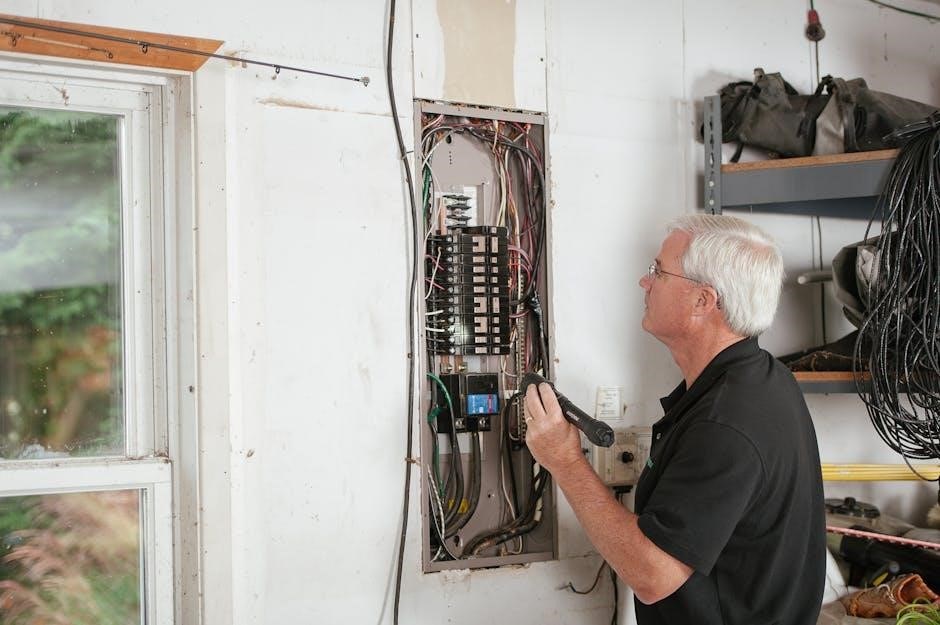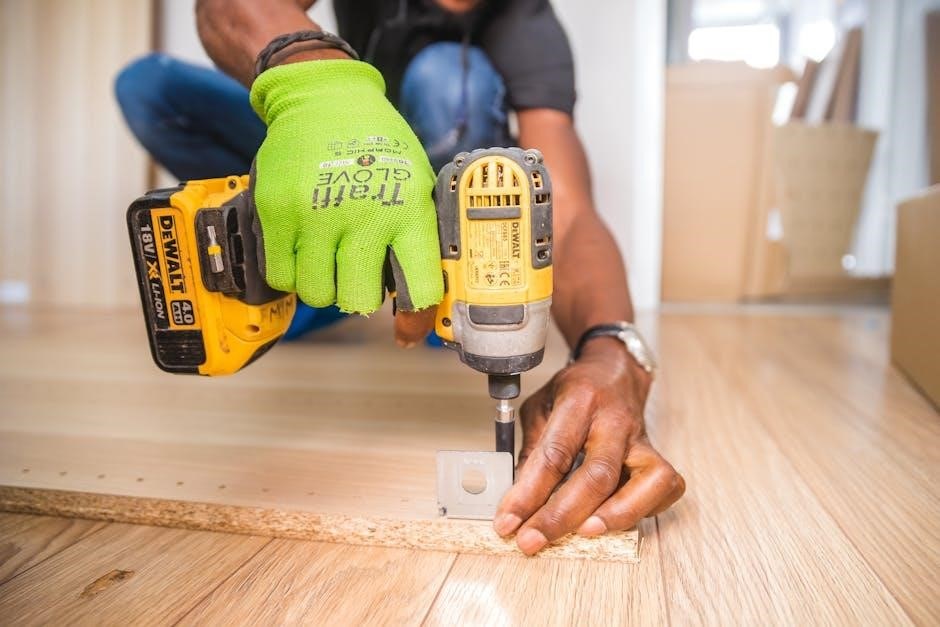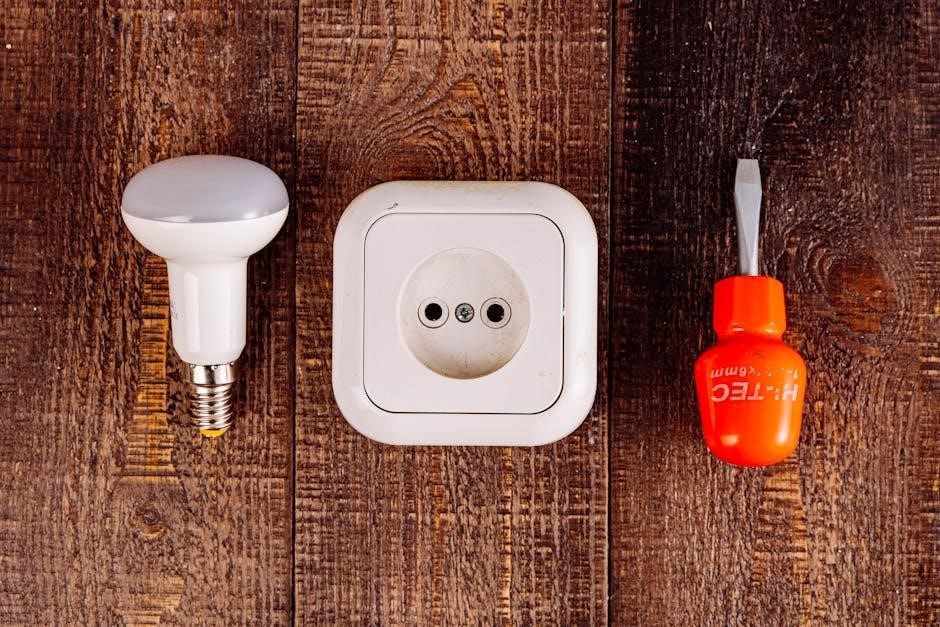The Honeywell 6000 Series Thermostats, including the Pro 6000 model, offer programmable temperature control for enhanced energy efficiency and comfort. Designed for ease of use, these thermostats provide advanced features like Wi-Fi connectivity and customizable scheduling options, making them ideal for modern HVAC systems.
1.1 Overview of the Honeywell Pro 6000 Thermostat
The Honeywell Pro 6000 Thermostat is a programmable digital thermostat designed for compatibility with a wide range of HVAC systems, including conventional and heat pump configurations. It offers advanced features like energy-saving modes, customizable scheduling, and remote access via Wi-Fi connectivity. The thermostat is user-friendly, with a clear display and intuitive controls, making it easy to adjust settings and monitor energy usage.
Its sleek design and programmable functionality ensure optimal temperature control, reducing energy bills while maintaining comfort. The Pro 6000 is part of Honeywell’s FocusPRO series, known for reliability and efficiency, making it a popular choice for homeowners seeking modern thermostat solutions.
1.2 Key Features of the Honeywell 6000 Series
The Honeywell 6000 Series thermostats are equipped with advanced features designed to enhance comfort and energy efficiency. They include programmable scheduling, energy-saving modes, and compatibility with both conventional and heat pump systems. The thermostat boasts a backlit display for improved visibility and user-friendly navigation. Additional features include touch screen models, humidity control, and remote sensors for precise temperature management. Wi-Fi connectivity enables smart home integration, allowing users to adjust settings via Honeywell’s Home app. Energy recovery and geofencing capabilities further optimize performance. These features make the Honeywell 6000 Series a versatile and efficient choice for modern HVAC systems.
- Programmable scheduling
- Energy-saving modes
- Humidity control
- Wi-Fi connectivity
- Geofencing capabilities

Pre-Installation Requirements
Verify system compatibility, ensure electrical requirements are met, and gather necessary tools. Shut off power to the HVAC system before starting installation to ensure safety.
2.1 System Compatibility Check
Before installing the Honeywell 6000 Series thermostat, ensure it is compatible with your HVAC system. The thermostat supports conventional heating, cooling, and heat pump systems. Verify the system type (e.g., 24V AC) and check for compatibility with multi-stage heating and cooling. Ensure the system’s wiring matches the thermostat’s terminal designations. For heat pumps, confirm the correct configuration of auxiliary heat and emergency heat settings. Refer to the thermostat’s specifications to confirm compatibility with your system’s voltage, stages, and wiring requirements. Proper compatibility ensures optimal performance and avoids installation issues. Always consult the HVAC system manual for specific compatibility details. This step is crucial for a seamless installation process.
2.2 Safety Precautions
Before starting the installation, ensure the HVAC system’s power is turned off at the circuit breaker or fuse box to avoid electric shock. Verify the system is completely cool to prevent burns. Use a voltage tester to confirm there is no power to the system. Handle wires carefully to avoid damage or short circuits. Do not attempt installation during severe weather or in humid conditions. Wear appropriate safety gear, including gloves and safety glasses. Ensure the work area is well-lit and clear of obstructions. Follow all local electrical codes and regulations. Always refer to the Honeywell 6000 Series installation manual for specific safety guidelines. Adhering to these precautions ensures a safe and successful installation process.

Installation Process
The Honeywell 6000 Series installation involves mounting the wallplate, connecting wires, and securing the thermostat. Follow step-by-step instructions for a smooth setup.
3.1 Tools and Materials Needed
To install the Honeywell 6000 Series thermostat, gather the necessary tools and materials beforehand. Required tools include a screwdriver, drill, and wire strippers. Materials needed are mounting screws, wall anchors, and possibly a voltage tester for safety. Ensure compatibility with your HVAC system by checking wiring requirements. A ladder may be needed for high walls, and a level can help align the thermostat properly. Refer to the manual for specific recommendations. Having all items ready ensures a smooth and efficient installation process.
3.2 Wallplate Installation
Begin by removing the old thermostat and carefully disconnecting the wires. Take note of the wire labels for reference during reconnection. Peel the adhesive backing from the wallplate and press it firmly onto the wall, ensuring it is level. If necessary, drill pilot holes and insert wall anchors before screwing the wallplate into place. For drywall or plaster, use the provided screws or anchors to secure the plate tightly. Align the wallplate with the wiring configuration to match your system. Once mounted, connect the wires to the appropriate terminals as per the wiring diagram in the manual. Double-check the alignment and ensure the wallplate is flush against the wall for a clean finish. Proper installation ensures reliable thermostat performance.
3.3 Wiring Terminal Designations involves understanding the labels on the thermostat terminals, which are crucial for correct installation. Each terminal corresponds to a specific function in the HVAC system. For instance, the R terminal is typically connected to the 24V power supply, while the W terminal controls the heating system, and the Y terminal operates the cooling system. The G terminal is designated for the fan, and the C terminal is the common wire. It’s essential to match each wire to the correct terminal as per the wiring diagram provided with the Honeywell 6000 thermostat. Proper wiring ensures efficient and safe operation of your HVAC system. Always double-check connections to avoid any operational issues and consult a licensed electrician if unsure.
3.4 Wiring Conventional Systems involves connecting the Honeywell 6000 thermostat to a standard HVAC system, typically including a furnace and air conditioner. Begin by ensuring the power is off at the circuit breaker. Use the wiring diagram provided with the thermostat to match each wire to the correct terminal. The R terminal connects to the 24V power supply, while the W terminal is for heating, and the Y terminal is for cooling. The G terminal controls the fan, and the C terminal is the common wire. Carefully connect each wire to its designated terminal, ensuring secure connections. Double-check the wiring to avoid mismatches. Once complete, turn the power back on and test the system to ensure proper operation. This process ensures compatibility with conventional 24V HVAC systems.
3.5 Wiring Heat Pump Systems requires careful attention to ensure proper functionality of the Honeywell 6000 thermostat with heat pump systems. Begin by disconnecting power at the circuit breaker. Refer to the wiring diagram to identify the correct terminals for your system. The R terminal connects to the 24V power supply, while the W terminal is for auxiliary heat. The Y terminal handles cooling, and the G terminal controls the fan. For heat pumps, the O or B terminal is used for the reversing valve, which switches between heating and cooling modes. Connect the wires securely to their respective terminals, ensuring no cross-connections. Double-check the wiring to match your system’s configuration. Once completed, restore power and test the system to confirm proper operation in both heating and cooling modes. This ensures the thermostat operates efficiently with your heat pump system.
3.6 Thermostat Mounting
Mounting the Honeywell 6000 thermostat securely ensures accurate temperature sensing and proper functionality. Begin by selecting a location approximately 52 inches above the floor, away from direct sunlight and drafts. Use the provided wallplate and screws to attach the mounting bracket to the wall. Ensure the wallplate is level and firmly secured, especially on uneven surfaces. Once the wallplate is installed, gently align the thermostat with the mounting bracket and snap it into place. Tighten the screws to hold the thermostat firmly. After mounting, connect the wires to their respective terminals as outlined in the wiring section. Finally, test the thermostat by turning on your HVAC system to ensure it responds correctly to temperature adjustments.

Initial Setup and Configuration
After installation, power on the thermostat and navigate through the menu to set basic parameters like temperature units, time, and date. Perform a system check.
4.1 Battery Installation
To power the Honeywell 6000 Series Thermostat, install two AA alkaline batteries. Locate the battery compartment on the rear of the thermostat. Open it by sliding it downward or removing the faceplate, depending on the model. Insert the batteries ensuring correct polarity (+ and ౼ terminals match the compartment markings). Replace the compartment securely. The thermostat will automatically power on and display the home screen. If the display does not activate, check battery orientation and connections. Avoid mixing battery types or using rechargeable batteries, as this may cause performance issues. Proper battery installation ensures reliable operation and maintains programmable features. Refer to the manual for specific model variations. Battery life typically lasts 1-2 years under normal use. Always turn off power to the HVAC system before handling the thermostat to prevent electrical hazards.
4.2 Basic Configuration Settings
After powering on the Honeywell 6000 Series Thermostat, navigate to the configuration menu using the touchscreen interface. Set the current date and time by selecting the clock icon and adjusting the values. Choose the desired temperature units (Fahrenheit or Celsius) from the settings menu. Select your HVAC system type (e.g., heat pump, conventional, or dual-fuel) to ensure proper operation. Configure the temperature range limits to avoid extreme settings. Set the fan operation to “Auto” or “On” based on your preference. Save all settings to apply them. The thermostat will now display the home screen with the current temperature and system status. These basic settings ensure the thermostat operates correctly with your HVAC system. Always refer to the manual for specific options tailored to your system type. Proper configuration enhances performance and efficiency.
4.3 Synchronizing with HVAC System
After completing the basic configuration, synchronize the Honeywell 6000 thermostat with your HVAC system. Access the “Installation” or “Settings” menu and select “System Type” to identify your HVAC equipment (e.g., heat pump, conventional, or dual-fuel). Ensure the thermostat is set to match your system’s stage of heating and cooling. For heat pumps, configure the reversing valve settings if necessary. Adjust the fan settings to coordinate with your system’s operation. Once configured, test the system by running a heating and cooling cycle to verify proper synchronization. Save the settings to ensure the thermostat communicates effectively with your HVAC system. Proper synchronization ensures optimal performance and compatibility. If issues arise, consult the manual or contact a professional. This step is critical for seamless operation. Always test the system after synchronization.

Installer System Test
The Installer System Test ensures the Honeywell 6000 thermostat operates correctly with your HVAC system. Test heating, cooling, emergency heat, and fan functions to confirm smooth operation. Follow manual guidelines for efficient system performance and to verify all components are functioning as expected.
5.1 Testing Heating System
To test the heating system, switch the Honeywell 6000 thermostat to heat mode and set the temperature 5°F above the current room temperature. The display should show the heating demand. Verify the HVAC system activates and heat is distributed properly. Check for any unusual noises or delays. Ensure the system cycles correctly and maintains the set temperature. If issues arise, refer to the error codes or troubleshooting guide. This step confirms the thermostat communicates effectively with the heating equipment, ensuring reliable performance during colder months.
5.2 Testing Cooling System
To test the cooling system with the Honeywell 6000 thermostat, switch to cool mode and set the temperature 5°F below the current room temperature. The display should indicate the cooling demand. Ensure the HVAC system activates and cools properly. Check for airflow through vents and verify the system cycles correctly. If the system does not activate, review wiring connections and ensure the thermostat is properly configured. Address any issues promptly to ensure efficient cooling performance during warmer months. Proper testing ensures the thermostat communicates effectively with the cooling equipment, maintaining a comfortable environment.
5.3 Testing Emergency Heat
To test the emergency heat function on the Honeywell 6000 thermostat, set the system to emergency heat mode. Lower the temperature setpoint below the current room temperature to activate the emergency heat. Verify that the HVAC system responds by engaging the emergency heating source. Ensure the system operates smoothly and heats the space effectively. If the emergency heat does not activate, check the wiring connections and system configuration. Address any issues promptly to guarantee reliable backup heating performance. Proper testing ensures the thermostat and HVAC system work together seamlessly during emergency heating situations, providing consistent comfort when needed most.
5.4 Testing Fan Operation
To test the fan operation on the Honeywell 6000 thermostat, switch the fan setting to the “On” position. Verify that the fan operates continuously, independent of heating or cooling demands. Next, set the fan to “Auto” mode and ensure it cycles on and off appropriately with the heating or cooling system. Check for any unusual noises or vibrations during operation. If the fan does not run in “On” mode or fails to cycle correctly in “Auto,” inspect the wiring connections and ensure proper installation. Proper fan operation is essential for maintaining consistent airflow and system efficiency. Address any issues promptly to ensure optimal performance and comfort.

Advanced Configuration Options
The Honeywell 6000 Series offers programmable schedules, energy-saving modes, and customizable settings. Users can adjust temperature ranges, fan operation, and system responses for enhanced efficiency and comfort. Advanced features include learning capabilities and smart home integration.
6.1 Programming Schedule
The Honeywell 6000 Series allows users to program custom schedules to optimize heating and cooling usage. The thermostat supports up to six daily periods, enabling precise temperature control. Users can set specific temperatures for wake, leave, return, and sleep times. The schedule can be programmed manually using the thermostat’s interface or via the remote sensor if connected. It is recommended to align the schedule with the household’s daily routines to maximize energy efficiency and comfort. The scheduler also includes an “hold” feature to temporarily override settings without disrupting the overall program. Programming is done through the menu, selecting the desired day and time, and adjusting the temperature setpoints accordingly. This feature ensures consistent comfort while reducing energy waste.
6.2 Energy-Saving Features
The Honeywell 6000 Series includes advanced energy-saving features designed to reduce utility bills while maintaining comfort. The thermostat incorporates smart recovery technology, which learns the HVAC system’s operation to pre-heat or cool the home efficiently. It also provides an energy usage report, allowing users to track consumption patterns and identify savings opportunities. Geofencing capabilities adjust temperatures based on the homeowner’s location, ensuring energy isn’t wasted when the house is unoccupied. Additionally, the thermostat offers an energy-saving mode that slightly adjusts setpoints to conserve energy without compromising comfort. These features work seamlessly with programmable schedules to optimize efficiency, making the Honeywell 6000 Series a cost-effective and eco-friendly solution for home climate control.
6.3 Customizing Thermostat Settings
The Honeywell 6000 Series allows users to customize thermostat settings to meet specific comfort and energy needs. Key customization options include programmable scheduling, temperature limits, and fan operation. Users can set up to six different temperature periods per day, ensuring optimal comfort while reducing energy waste. Additionally, the thermostat offers adjustable temperature swing settings, which determine how much deviation from the setpoint is allowed before the HVAC system activates. Customizable fan settings enable continuous or periodic operation to improve air circulation. These features can be easily adjusted via the thermostat’s interface, providing a user-friendly experience. Customization ensures the system operates efficiently and aligns with personal preferences, enhancing both comfort and energy savings.

Wireless Connectivity Setup
To set up wireless connectivity for the Honeywell 6000 Series, ensure the thermostat is powered on and navigate to the Wi-Fi setup menu. Select your network from the list, enter your password, and wait for confirmation. For remote access, enable the feature in settings. If issues arise, restart the device and router or consult the manual for troubleshooting.
7.1 Connecting to Wi-Fi

To connect the Honeywell 6000 Series thermostat to Wi-Fi, ensure the device is powered on and navigate to the Wi-Fi setup menu. Select your network from the available list and enter the password using the touchscreen interface. The thermostat will attempt to connect to the network. Once connected, a confirmation message will appear. If the connection fails, verify the network name and password, and ensure the router is functioning properly. Restarting the thermostat and router may resolve connectivity issues. The LED indicator will change color to confirm successful connection. Follow on-screen prompts for additional guidance if needed.
7.2 Remote Access Configuration
After connecting to Wi-Fi, configure remote access to control the Honeywell 6000 Series thermostat via the Honeywell Home app. Download and install the app from the App Store or Google Play. Create a Honeywell account or log in if you already have one. Link the thermostat to your account by selecting it from the app’s device list or scanning the QR code on the thermostat. Ensure the thermostat is connected to the same Wi-Fi network as your smartphone. Configure settings like geofencing or smart alerts for enhanced functionality. Test remote access by adjusting settings through the app to ensure proper operation. Secure your account with a strong password and enable two-factor authentication for added security.

7.3 Troubleshooting Wireless Issues
If the Honeywell 6000 Series thermostat fails to connect to Wi-Fi or loses connection, restart the thermostat and router. Ensure the thermostat is within range of the router and no physical obstructions are present. Check the Wi-Fi signal strength on the thermostat’s screen. Verify that the correct network name and password were entered. If issues persist, perform a factory reset of the thermostat and reconfigure Wi-Fi settings. Update the thermostat’s firmware to the latest version. Ensure the router is operating on the 2.4GHz band, as 5GHz is not supported. Use the Honeywell Home app to test network diagnostics. If problems remain, contact Honeywell support for further assistance.

Troubleshooting Common Issues
Identify common issues like display malfunctions, system delays, or error codes. Consult the user manual for solutions or contact Honeywell support for professional assistance.
8.1 Display Issues
If the display is blank, dim, or flickering, first ensure the thermostat is powered on. Check battery levels or wiring connections for any damage or looseness. Verify that the thermostat is properly mounted and level. Clean the display gently with a soft cloth to remove dirt or smudges. If the issue persists, reset the thermostat by removing the batteries for 10 seconds or toggling the circuit breaker; Ensure all wiring is secure and correctly connected. If the display remains unresponsive, contact Honeywell support for further assistance or potential replacement. Always refer to the user manual for specific troubleshooting steps tailored to your model.
8.2 System Response Problems
If the HVAC system fails to respond to temperature changes or thermostat commands, check the wiring connections for looseness or damage. Ensure the thermostat is properly synchronized with the HVAC system. Verify that the system switch is set to the correct mode (HEAT, COOL, or AUTO). Check for blown fuses or tripped circuit breakers. Review the wiring terminal designations to confirm they match the system requirements. If the issue persists, reset the thermostat by removing batteries or toggling the power switch. Consult the user manual for specific reset procedures. If problems remain, contact Honeywell support for assistance, as internal thermostat or system issues may require professional attention. Always ensure proper installation and configuration to maintain optimal performance.
8.3 Error Codes and Solutions
The Honeywell 6000 Series may display error codes to indicate specific issues. For example, E1 typically signifies a problem with the temperature sensor, while E2 may indicate communication issues between the thermostat and the HVAC system. E30 often points to wiring or power supply problems. To resolve these, ensure all connections are secure and verify wiring integrity. For sensor-related errors, clean the sensor and check its placement. If communication errors persist, restart the system by toggling the power. Always refer to the user manual for code-specific solutions. If issues remain unresolved, contact Honeywell customer support for further assistance. Regular maintenance and correct installation can help minimize error occurrences.
Maintenance and Upkeep
Regular maintenance ensures optimal performance. Clean the thermostat monthly, check wiring connections annually, and ensure firmware updates. Replace batteries as needed and verify proper wall mounting.
9.1 Battery Replacement Guidelines
To maintain uninterrupted operation, replace the Honeywell 6000 thermostat batteries annually or when the low-battery indicator appears. Use 2 AA alkaline batteries for optimal performance. Turn off the thermostat before replacing batteries to prevent system glitches. Open the battery compartment located on the back or side of the thermostat, depending on the model. Ensure proper polarity alignment when inserting new batteries. Avoid mixing old and new batteries or using rechargeable types, as this may affect reliability. After replacement, close the compartment securely and verify the display lights up. If issues persist, consult the user manual or contact customer support for assistance. Regular battery checks ensure consistent heating and cooling system operation.
9.2 Software Updates
Regular software updates are essential to ensure the Honeywell 6000 thermostat operates at peak performance. Updates often include new features, performance improvements, and bug fixes. To check for updates, navigate to the thermostat’s menu, select “Settings,” and choose “Software Update.” If an update is available, follow on-screen instructions to download and install it. Always use a stable Wi-Fi connection for updates to prevent interruptions. Some updates may require a manual download from Honeywell’s official website, which can then be transferred to the thermostat using a USB drive. Never interrupt the update process, as this could cause system instability. After completion, the thermostat will restart automatically. For detailed instructions, refer to the user manual or contact Honeywell support if issues arise.
The Honeywell 6000 Series Thermostat installation process, when followed diligently, ensures optimal performance and energy efficiency. By adhering to the guidelines outlined in this manual, users can enjoy precise temperature control, advanced features, and seamless integration with their HVAC systems. Regular maintenance, such as software updates and battery replacements, will prolong the thermostat’s lifespan and functionality. With its user-friendly interface and cutting-edge technology, the Honeywell 6000 Series is designed to enhance comfort and reduce energy consumption. Proper installation and configuration are key to unlocking its full potential, making it an excellent choice for modern smart home systems. Refer to this manual for any future adjustments or troubleshooting needs.



